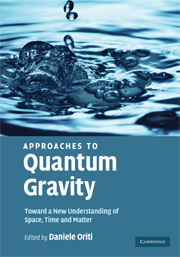Book contents
- Frontmatter
- Contents
- List of contributors
- Preface
- Part I Fundamental ideas and general formalisms
- Part II String/M-theory
- Part III Loop quantum gravity and spin foam models
- 13 Loop quantum gravity
- 14 Covariant loop quantum gravity?
- 15 The spin foam representation of loop quantum gravity
- 16 Three-dimensional spin foam Quantum Gravity
- 17 The group field theory approach to Quantum Gravity
- Questions and answers
- Part IV Discrete Quantum Gravity
- Part V Effective models and Quantum Gravity phenomenology
- Index
16 - Three-dimensional spin foam Quantum Gravity
from Part III - Loop quantum gravity and spin foam models
Published online by Cambridge University Press: 26 October 2009
- Frontmatter
- Contents
- List of contributors
- Preface
- Part I Fundamental ideas and general formalisms
- Part II String/M-theory
- Part III Loop quantum gravity and spin foam models
- 13 Loop quantum gravity
- 14 Covariant loop quantum gravity?
- 15 The spin foam representation of loop quantum gravity
- 16 Three-dimensional spin foam Quantum Gravity
- 17 The group field theory approach to Quantum Gravity
- Questions and answers
- Part IV Discrete Quantum Gravity
- Part V Effective models and Quantum Gravity phenomenology
- Index
Summary
Introduction
Loop quantum gravity provides a background independent approach to Quantum Gravity. In this context the kinematical Hilbert space is spanned by spin networks (graph labeled by Lorentz group representations) which are eigenstates of geometrical operators. The dynamics of such theories is encoded in a set of transitions amplitudes between initial and final spin network states which carry the information about the physical inner product of the theory. Generically, these amplitudes are constructed in terms of spin foam models which are local state sum models associated with a sum of colored 2-complexes interpolating between initial and final spin network states.
There are many important questions that need to be addressed in this framework such as the proper choice of the dynamics, the construction and interpretation of the spin foam amplitude, the coupling to matter and the description of the semi-classical regime of such a theory. The contributions of D. Oriti and A. Perez in this volume address some of these issues.
In this contribution we will focus on the simple case of three-dimensional gravity and its quantization via spin foam models. The advantage of using the spin foam framework is twofold. First, this framework is not specifically tailored to three dimensions, unlike Chern–Simons quantization for instance, and some of the lessons and techniques used there can be useful for the more realistic four-dimensional case.
- Type
- Chapter
- Information
- Approaches to Quantum GravityToward a New Understanding of Space, Time and Matter, pp. 290 - 309Publisher: Cambridge University PressPrint publication year: 2009

